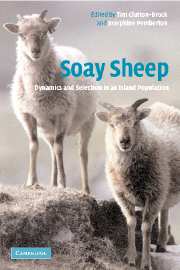Book contents
- Frontmatter
- Contents
- List of contributors
- Editors' and Authors' Acknowledgements
- 1 Individuals and populations
- 2 The sheep of St Kilda
- 3 Population dynamics in Soay sheep
- 4 Vegetation and sheep population dynamics
- 5 Parasites and their impact
- 6 Mating patterns and male breeding success
- 7 Selection on phenotype
- 8 Molecular genetic variation and selection on genotype
- 9 Adaptive reproductive strategies
- 10 The causes and consequences of instability
- Appendix 1 The flora of St Kilda
- Appendix 2 Inheritance of coat colour and horn type in Hirta Soay sheep
- Appendix 3 How average life tables can mislead
- References
- Index
- Plate section
Appendix 1 - The flora of St Kilda
Published online by Cambridge University Press: 07 December 2009
- Frontmatter
- Contents
- List of contributors
- Editors' and Authors' Acknowledgements
- 1 Individuals and populations
- 2 The sheep of St Kilda
- 3 Population dynamics in Soay sheep
- 4 Vegetation and sheep population dynamics
- 5 Parasites and their impact
- 6 Mating patterns and male breeding success
- 7 Selection on phenotype
- 8 Molecular genetic variation and selection on genotype
- 9 Adaptive reproductive strategies
- 10 The causes and consequences of instability
- Appendix 1 The flora of St Kilda
- Appendix 2 Inheritance of coat colour and horn type in Hirta Soay sheep
- Appendix 3 How average life tables can mislead
- References
- Index
- Plate section
Summary
The following systematic list of the vascular plants of St Kilda shows the grazing impacts of Soay sheep in different habitats. Nomenclature follows Stace (1997), and data are from M. J. Crawley (unpublished data) and Pankhurst and Mullin (1991).
The key to the habitats is as follows: I, sea cliffs and ungrazed places like inaccessible cleit-tops; II, freshwater wetlands and Iris mires; III, stream banks; IV, fertile grasslands within the Head Dyke; V, heaths and drier heathy grasslands; VI, mires and wet heathy grasslands; VII, Plantago sward and short seaside turf; VIII, walls, cleits and inland cliffs; IX, summit heaths and exposed places above 250 m, including the extensive Nardus–Racomitrium grasslands; X, The Village, the Army Base and in the vicinity of cleit doors.
The column headed ‘Dafor’ gives ranked abundance. The key is: d, dominant; a, abundant; f, frequent; o, occasional; r, rare; l, locally (prefix).
In the column headed ‘Seen’, plants are recorded on Hirta since 1993 by MJC unless noted by No (these are from published records in Pankhurst and Mullin (1991)). Those ruderals that might persist as dormant seeds in the soil seed bank are noted as? SB.
In the column headed ‘Grazing response’ the key is: I, increasers (unpalatable species that increase in abundance under moderate to heavy grazing by sheep); D, decreasers (highly palatable species that decline in abundance under grazing; many species exhibit reduced rates of flowering and seed production under grazing, but do not decline markedly in abundance).
- Type
- Chapter
- Information
- Soay SheepDynamics and Selection in an Island Population, pp. 311 - 320Publisher: Cambridge University PressPrint publication year: 2003

